Here are two versions of Pickled Asparagus using the same brine so you can make two different kinds at once. Start with Dill and Garlic in the first batch and finish with Sweet and Hot in the second. It’s an easy pickling recipe and they’re ready to eat in as little as a few weeks. But they store for ages.
I wish we could get fresh local asparagus year round. But we can’t, so this is one way of preserving them. A fun way actually, because you can be a bit creative in what you choose to add to the jar. You don’t need any special equipment to make these so this is a great option for someone who hasn’t made pickles before. This is a very forgiving method. And, you can make a few jars and put the remaining brine in the fridge to make a few more later. It’s that easy.
After some discussion with my mom, an expert pickle maker, we decided that you don’t need to blanch the asparagus first. She doesn’t make pickled asparagus but we agreed that they would be too soft. Once you pour boiling brine over them, they’ll cook a bit. The brine has alum in it which helps to keep pickles crunchy. I’ve had alum in my pantry for years and I’m not sure if it’s even effective after this long but they did maintain their crunch so….maybe. If you don’t have any I wouldn’t worry about it unless you’re expecting the pickle police to stop by.
This recipe is included in a free downloadable collection of asparagus recipes by Yummy Farm in partnership with Ontario Asparagus. Click here to see the collection.
Jump to Recipe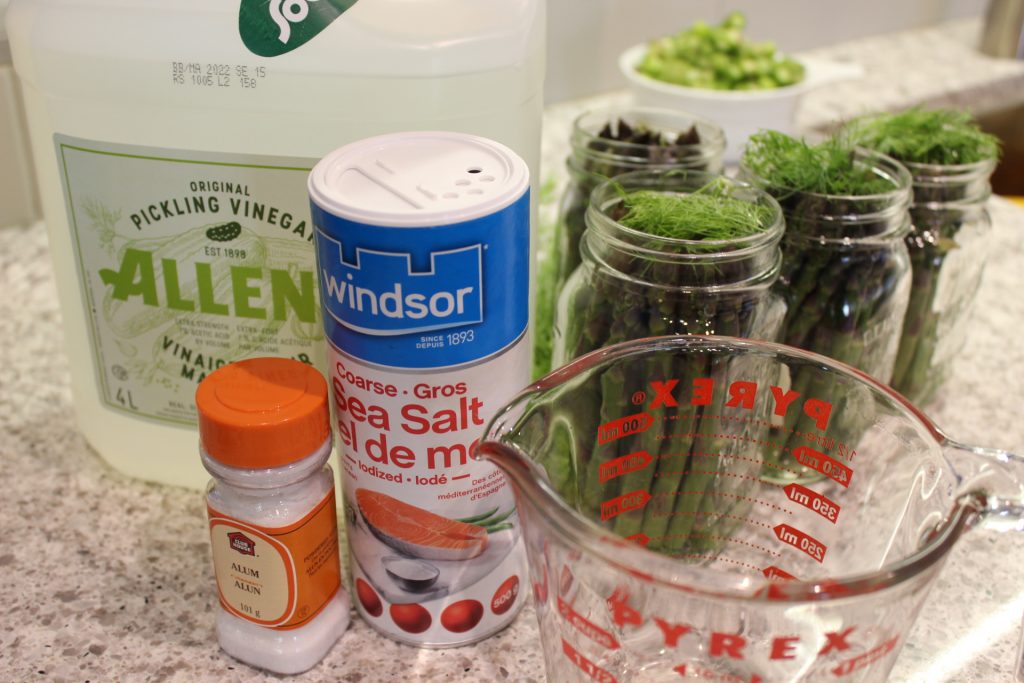 You’ll want to start the water bath first because it takes a while for a large pot to come to a boil. Fill a deep pickling pot with enough water to cover the jars over the lids when immersed on the rack and bring to a boil. You can also use a double boiler if it’s deep enough.
You’ll want to start the water bath first because it takes a while for a large pot to come to a boil. Fill a deep pickling pot with enough water to cover the jars over the lids when immersed on the rack and bring to a boil. You can also use a double boiler if it’s deep enough.
How to make pickled asparagus
Start by rinsing the asparagus well and snapping off the woody ends. Remember that asparagus from Norfolk County is grown in sandy soil so rinsing is very important. Look for nice fresh picked asparagus with tightly closed heads. The thinner spears look nicer in the jars and you can pack more of them in. But any thickness will work.
Cut one spear to the desired length to fit perfectly in the jar, then use that spear as a guide to cut the rest. Line them up at the top and chop off the bottoms evenly. You can use the bottoms in the jars too or save them to make Roasted Garlic and Asparagus Soup.
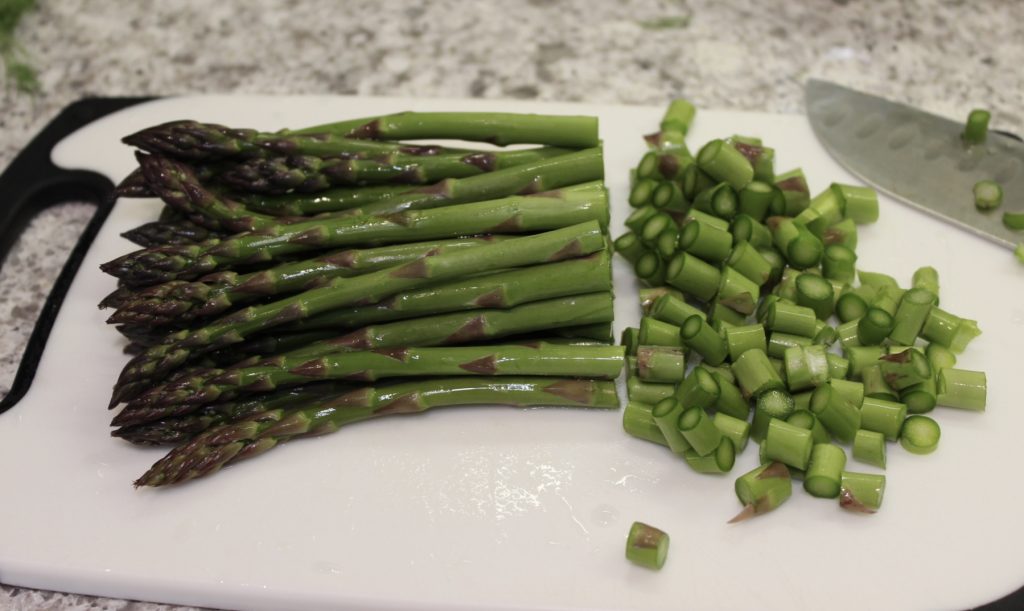
Wash 7 pint sized jars in hot soapy water or the dishwasher. A pint is 500 ml or 2 cups. You can actually use any size of jars you want but these are not too tall or short. They look nice filled with full spears facing upright. Depending on how tightly you pack the jars, you may have enough brine left to make an 8th jar. I usually save the odd sized pieces and make the last jar for the fridge. And if you’re really good at packing those jars tightly and you’re not hiding some of the bottom pieces in there, you may need more than 6 pounds of asparagus.
Dill and Garlic Pickled Asparagus
This version is based on the basic Dill Pickle recipe I use and is almost entirely the same. So if it’s not asparagus season you can make pickled cucumbers just as easily.
Put a frond of fresh dill in the bottom of each jar, along with a peeled clove of garlic. Fill each jar with upright asparagus spears, tightly packed, making sure the spears are just below the top. If you lay the jar on its side, it’s easier to get them started evenly.
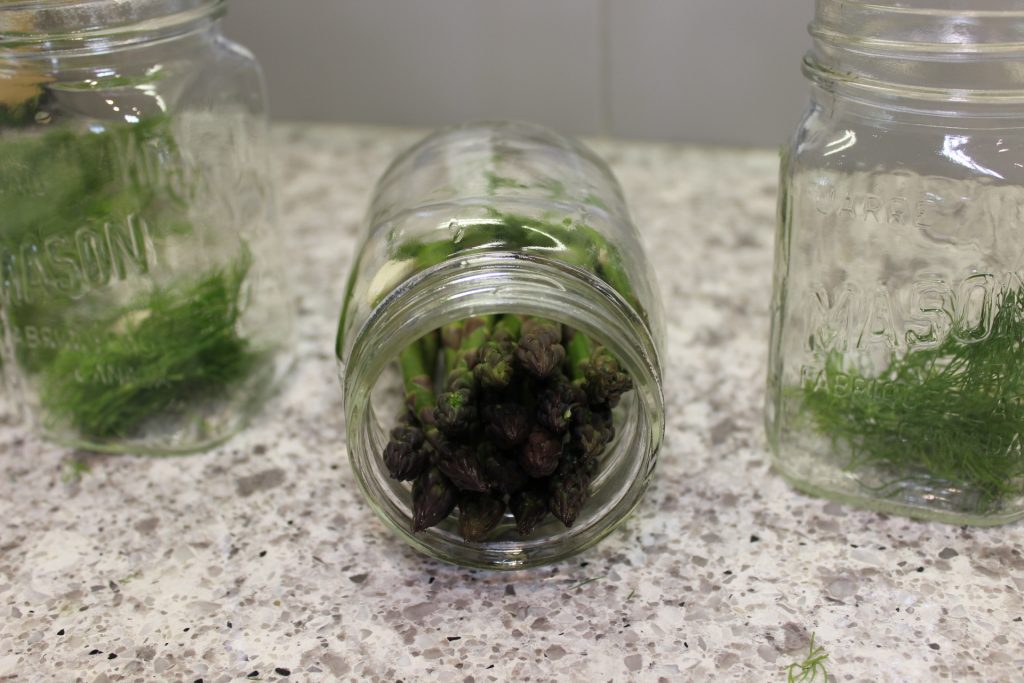
Add another frond of dill to the top of each jar. The fronds don’t have a strong dill flavour so pack enough in so that you don’t just taste garlic. If you can find dill weed, they have a better dill flavour but around here they tend to show up after asparagus season ends. You could add some dill seed for stronger flavour if you have some on hand.
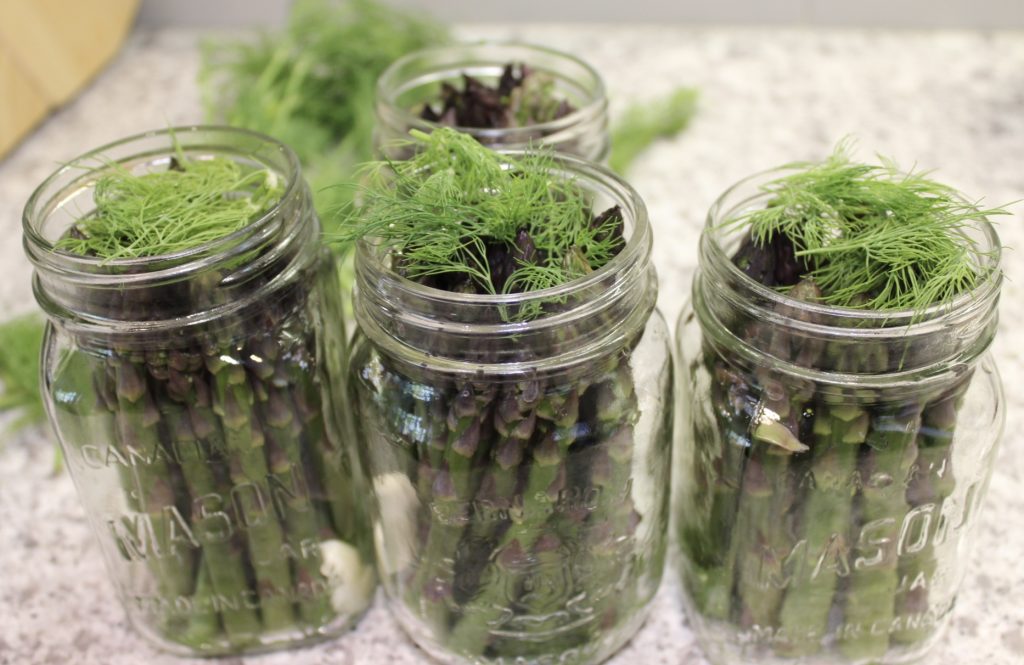
Combine the water, vinegar, alum and course salt in a heavy saucepan. Any pure course salt works like pickling salt or kosher salt. Table salt has additives to keep it from clumping so it’s not the best choice. It might even make the brine cloudy. Bring to a boil to ensure the salt has dissolved. I’m using pickling vinegar which has an acidity level of 7% which is higher than regular vinegar, normally 5%. I like the extra pucker power but regular vinegar works fine. Pour hot brine over the jarred asparagus, leaving a little bit of room at the top, around 1/4 of an inch.
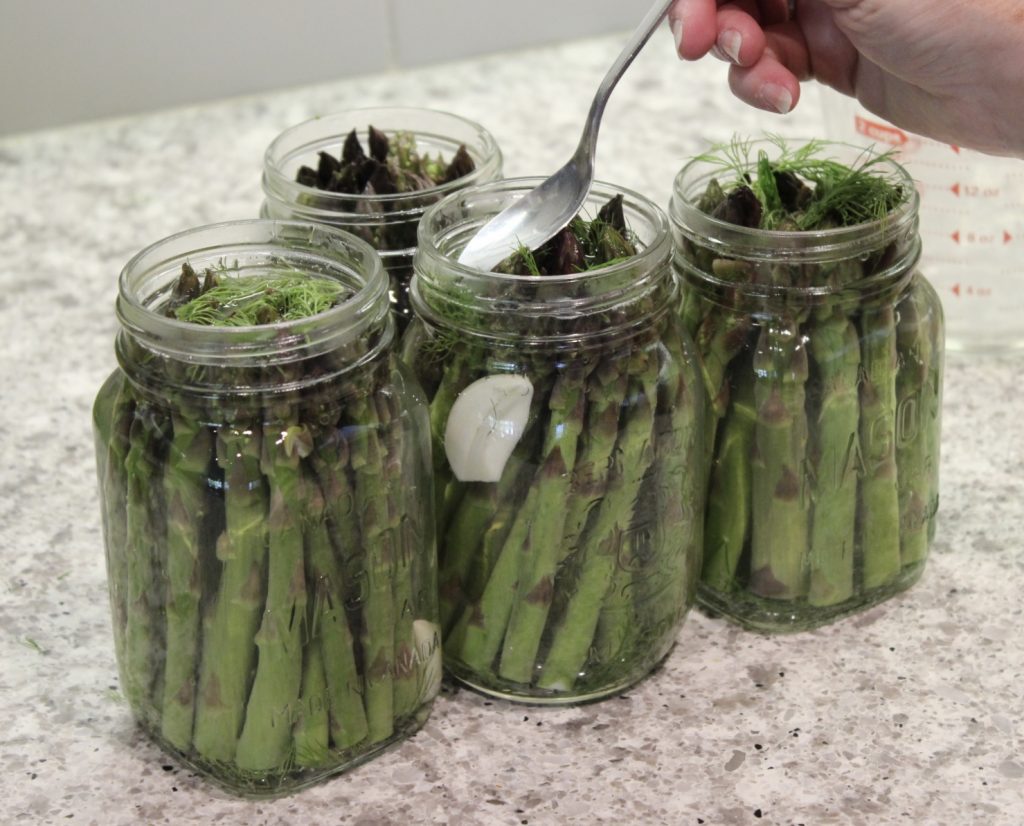
Use a spoon to make sure there’s no dill on the edge of the jar, otherwise you may not get a tight seal. Also, use a clean dishcloth to wipe the top edge.
You should always use new seals for the jars when you’re making pickles. Heat the lids and seals in simmering water to soften the rubber seal before putting them on the hot jars. You can actually just heat up the seals but they’re flat so good luck getting them off the bottom of the pan. It’s easier to grab the edge of the lid with tongs, tip the water out and flip them onto the jars. Some manufacturers of canning lids are now saying you don’t need to (or want to) heat them up but I still like to do a quick dip to soften the seal.
Since you’ve already got simmering water ready for processing, use tongs to lower the lids with seals inside into the water for about 30 seconds. That’s long enough. Tip the water out and place the lids on the jars. Tighten but not too much.
Water bath canning
The purpose of the water bath is to process the jars so they can be stored in the pantry. As the jars cool, they form a tight seal. Also any bacteria is killed by heating the contents. The vinegar also acts as a safety net to ensure there’s no bacteria left around. If you don’t have a pickling pot you can be creative.
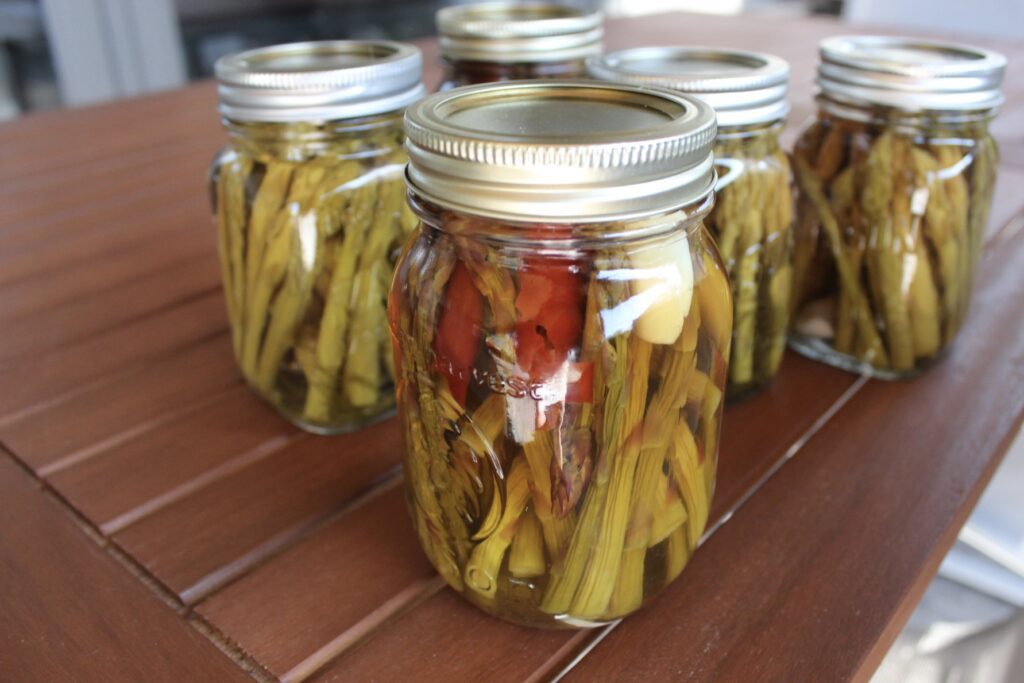
You just want to keep the jars off the bottom of the pot and keep them from touching each other. Place the jars in the rack, then carefully lower into the pot. If you don’t have a rack you can put a dishcloth in the bottom of the pot. Immerse the jars completely and boil for 10 minutes. Remove the jars carefully and allow to cool. You may hear them pop as they cool, that’s a good sign. The metal top should be slightly indented. You will have to do this in a few batches. If you’re doing tiny jars or larger jars, adjust the water bath time accordingly, so maybe 6-7 minutes for smaller jars and 12-13 minutes for larger.
If you prefer to skip the water bath processing, just put the jars in the fridge. They’ll keep for a ages. My friend Lisa who runs the local asparagus farm says the woman who passed down her Pickled Asparagus recipe to her recommends waiting a year before opening them. We can’t wait that long. You can open them in a few weeks but they’re best left at least a month.
Sweet and Hot Pickled Asparagus
While the Dill and Garlic Pickled Asparagus are cooling, get ready to make the Sweet and Hot batch. Or, you can put the pot of brine in the fridge and make it later.
Add sugar to the remaining brine and bring back to a boil. If you made 4 jars of dill, use a little less than 2/3 cup of sugar. If you made 3 jars of dill, use just over 3/4 cup of sugar. You can make an entire batch of Sweet and Hot, just use 1 1/2 cups.
Fill each jar with asparagus spears. Add 1 tsp of pickling spice to each jar along with a small clove of garlic and a dried or fresh hot chili pepper. I used a dry pepper and crushed it somewhat. You want the seeds to be in the mixture to make sure its hot. You can use any type of pepper, keeping in mind some are hotter than others. Pick out some of the cloves from the pickling spice mix if you like. I did. I find them a bit too strong.
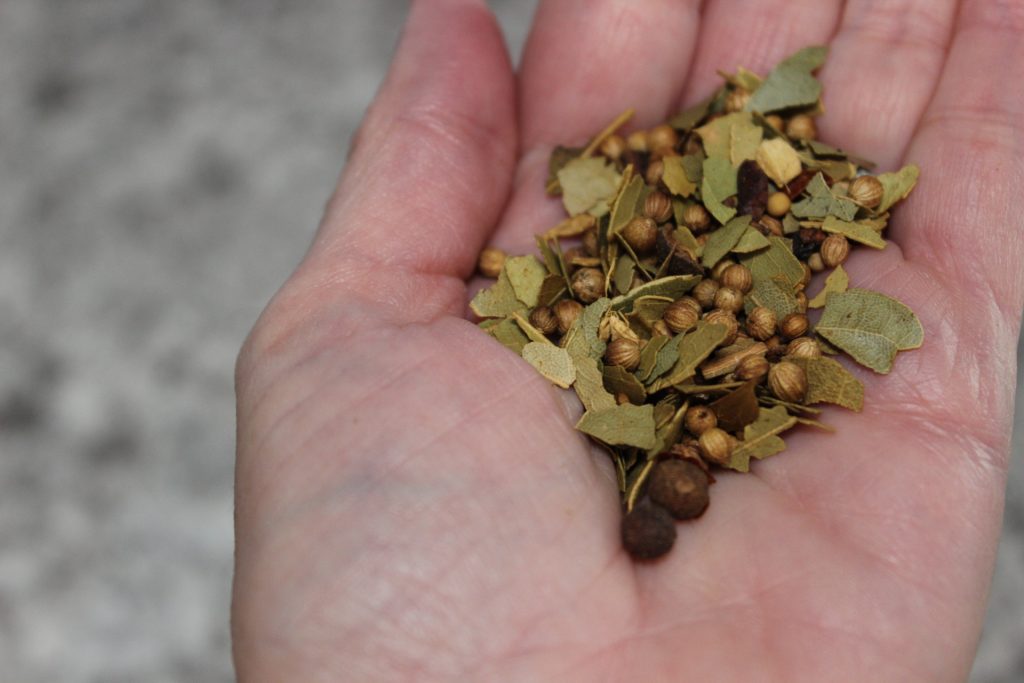 The cloves are at the bottom.
The cloves are at the bottom.
Pour the sweet brine over the jars and seal using the same technique as before. Process for the same amount of time as the dills. If the peppers tend to float up to the top and pop out, pierce them with a knife to let out the trapped air and they’ll stay down.

They tend to get hotter the longer they sit.
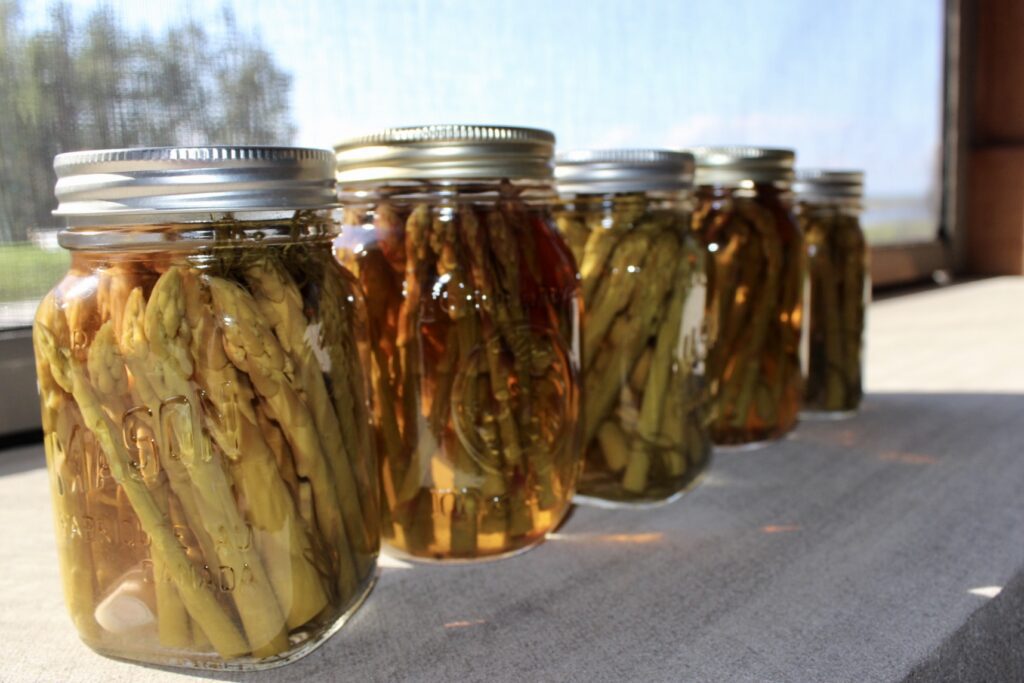
You may notice a pinkish colour to the brine. This is the pigment that gives beets their colour. Certain growing conditions like cold nights increase the amount of that pigment in asparagus. Also, the asparagus will shrink after processing so don’t worry if a few spears aren’t covered by the brine when you first pour it in the jars. And if your garlic turns bluish it’s not anything to worry about either, it’s a chemical reaction with the salt.
Here’s the recipe:
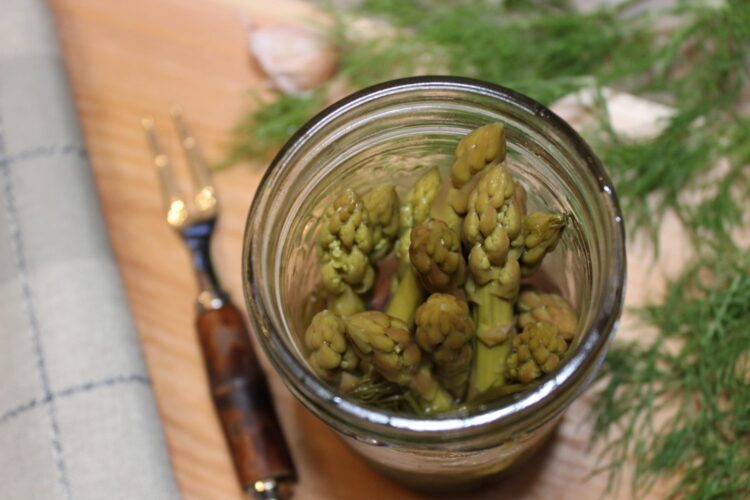
Equipment
- Canner
Ingredients
- 6 lb fresh asparagus allows for trimming, may need more if jars are packed tightly and ends aren't used
- 7 cups water
- 3 cups pickling vinegar or regular white vinegar
- 3 Tbsp course sea salt table salt is not the best option but if using, 1.5 Tbsp is enough
- ¼ tsp alum optional
- ⅔-¾ cup white sugar
- fresh dill sprigs
- garlic cloves
- 1 Tbsp pickling spice removed cloves if desired
- hot peppers dried or fresh
Instructions
- Wash 7 pint jars in hot soapy water or in dishwasher.
- Rinse asparagus and snap off woody ends. Cut spears to fit in jars and fill tightly. Lay spears upright and fit leftover pieces without tips in the centre for best appearance.
- Prepare brine by combining water, pickling vinegar, salt and alum in pot with pour spout. Heat to boiling.
- Bring a very large pot or canner to a boil. Fill with enough water to cover jars when inserted.
For Dill and Garlic Pickled Asparagus
- Put a frond of dill and a clove of garlic in the bottom of each jar. Fill tightly with asparagus and top with more dill.
- Pour hot brine into each jar, leaving about ¼ inch space at the top.
For Sweet and Hot Asparagus
- Add appropriate amount of sugar to remaining brine according to how many jars left. Use ⅔ cup if making 3 jars or ¾ cup if making 4. Return to boil until sugar dissolves. Add pickling spice while boiling. Remove cloves from mixture if too many are in spoonful.
- Add a clove of garlic and a hot pepper to each jar. Fill with asparagus, arranging as above in upright position for best appearance.
- Pour hot brine into jars leaving ¼ inch of space. Try to get similar amounts of pickling spice in each jar.
For All Jars
- While waiting for canner pot to come to a boil, wipe each jar rim to ensure nothing is on it to interfere with tight seal.
- Dip new lids with seals into hot water for about 30 seconds. Using tongs, carefully tip water out of each lid and place on top of jars.
- Tighten each lid. Do not over tighten.
- Using rack or by placing a kitchen towel in the bottom of the pot, carefully lower jars into boiling water, ensuring entire jar is covered. Cover pot and boil for 10 minutes. You may need to do this in batches depending on the size of your pot.
- Remove and cool on counter. Seals will "pop" as they invert during the cooling process. Any jars that don't seal properly can be stored in the refrigerator.
- Pickles can be opened in a few weeks but are best left at least a month and last for ages in the pantry.

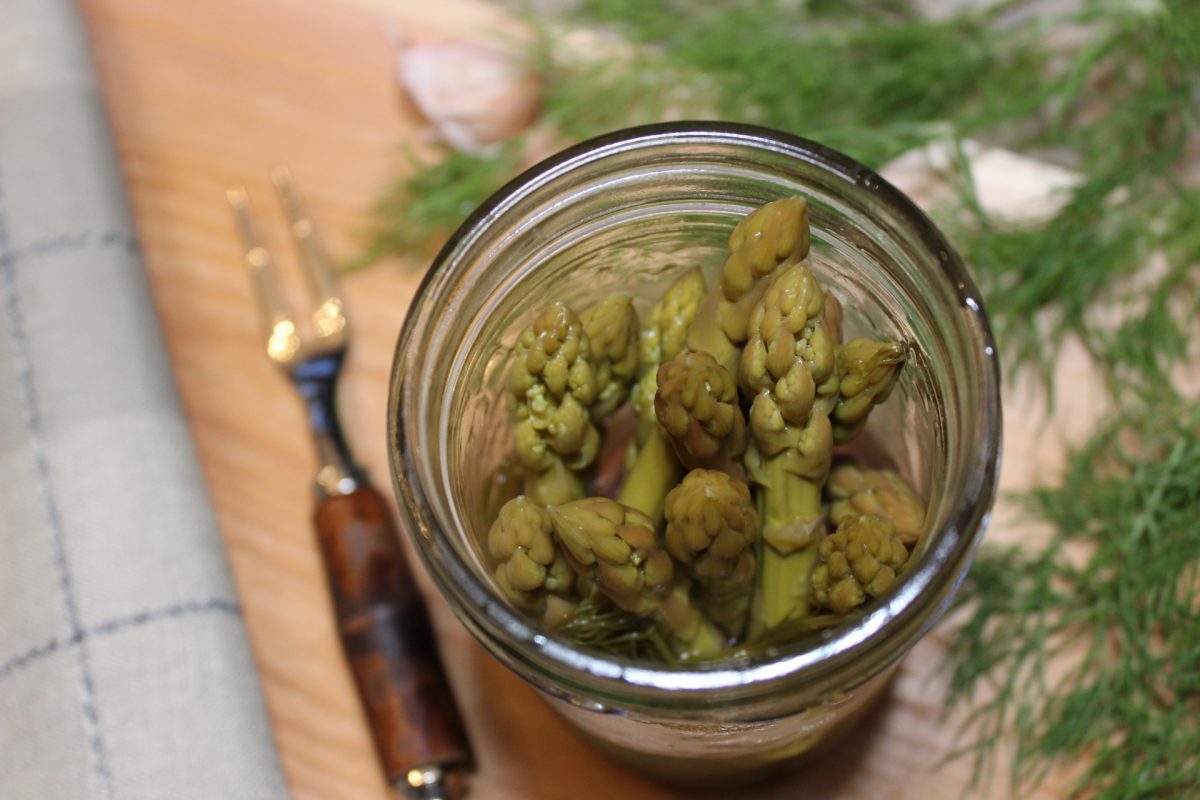
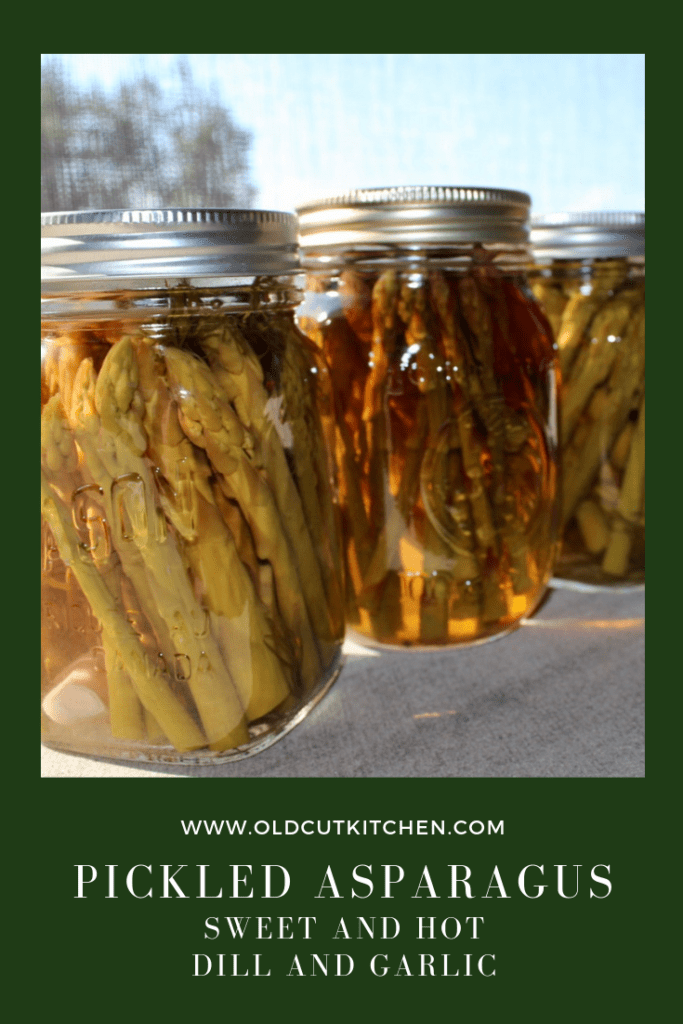
One thought on “Pickled Asparagus”